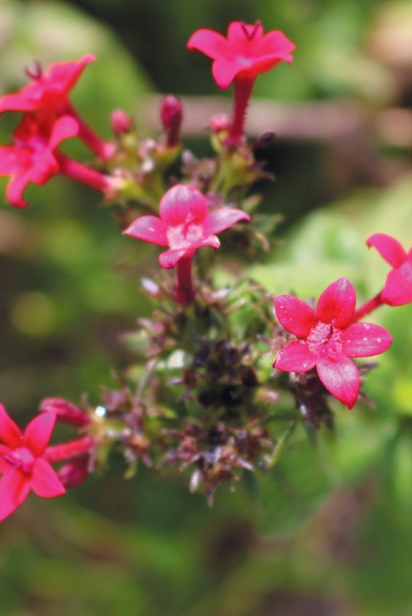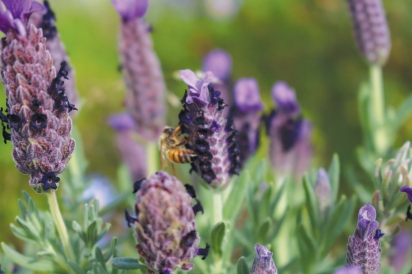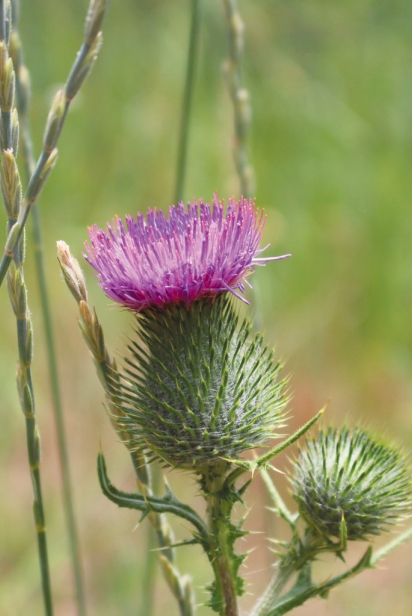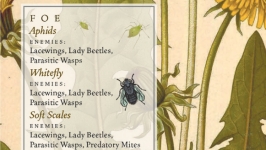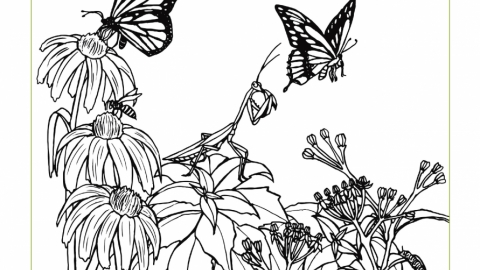Who Let The Bugs Out?
Growing up in rural Ventura County in the late l950s and early ’60s, Phil White was entranced by the variety and profusion of bees, butterflies, colorful moths and other bugs flitting around the orchard properties where he played as a boy. He went on to become an avid collector, putting together boxes of mounted insects as a project for 4-H, which won him a trophy at the county fair. He took an entomology (the study of bugs) class in college, and still uses a black light at night to attract insects such as moths to add to his collection of Ojai-area bugs.
But White hasn’t seen one of the more interesting local insects—the spectacularly large Polyphemus Silk Moth—in decades, and it worries him.
“I think it’s been 50 years since I’ve seen a Polyphemous moth,” White says. “They’re easy to recognize—they can be as wide across as your hand.”
White, who now serves on Ventura County’s Planning Commission, recalls working at a gas station in his youth, and commonly seeing the windshields of cars crusted with smashed insects.
Describing what he calls the “windshield survey,” White says, “The number of insects intercepted by cars these days is a small fraction of what it was 50 years ago. That is some of the best evidence of the decline of insect populations in our lifetimes.”
White is not alone in his concern for the insects of Ventura County.
Rick Krause grew up nearby in San Fernando Valley at about the same time, and he too collected butterflies. Years later, while living in the Bridle Path community in Simi Valley, he became aware that he wasn’t seeing the butterflies he loved as a boy. In 2011 he and his wife, Lynne Godin, began encouraging Monarch butterfly populations with a variety of nectar flowers and plantings of native milkweed—the host plant on which the butterfly depends. Their property was soon certified as a
Monarch Waystation, and within two years they added a nursery for milkweed and nectar-producing plants, and several large netted cages where Lynne raises butterflies.
In 2016 they moved to Thousand Oaks in retirement and created another Monarch Waystation for the charismatic butterflies. They say they’ve raised and released over 10,000 Monarchs since that first milkweed was planted.
Given that the population of Western Monarch butterflies roosting along the California Coast has plummeted to a tiny fraction of its estimated numbers in the l980s, Krause and Godin’s actions on behalf of the butterfly look heroic. (See infograph here.)
WHY SHOULD WE CARE?
But why should we care about a few wayward bugs and their possible population decline? Researchers around the world have in recent months sounded the alarm, warning of an “insect apocalypse” that could have grave consequences not just for insects and the wild creatures on which they depend, but for humanity itself. According to the Department of Entomology at Purdue University, insects are deeply underappreciated in their roles both as pollinators for our food supply and as an integral part of the food chain themselves.
Could the decline of this Monarch species be representative of a sharp decline in both the volume of insects and the variety of insect species reported recently? I asked this question to insect experts of all sorts, including scientists, beekeepers, vector control administrators and Monarch butterfly supporters.
None of these experts dismissed or minimized the concerning research.
ACADEMIC BUZZ
Anna Howell, an entomologist specializing in the study of native bees and agricultural pests for UC Cooperative Extension, and Art Shapiro, of UC Davis, who oversees (and does most of ) an annual scientific survey of butterflies in California, both express a balanced concern about the headline-grabbing news of insect decline.
“I’m not a doomsday person,” Howell says. “I try to be optimistic about issues.” She pointed as a hopeful example to the Urban Bee Lab of UC, Berkeley, where researcher Gordon Frankie, by planting a diverse array of native plants and food sources, has attracted numerous species of native bees known to live in the area, but which are not usually found in the city.
“It’s very localized. We can’t necessarily say that because we see a decline in one species in one area that we will find declines everywhere,” she says. “We do know that a lot of human activities are contributing to these declines. Habitat loss is one. Climate change is another. We have different invasive species that contribute to the decline of some species, and the overuse of some chemistries.”
“Yes, we have cause for concern [about insect decline],” Shapiro says. “At the same time, screaming like Chicken Little that the sky is falling is not useful and probably premature. We need to know a lot more to understand what’s going on.”
Shapiro was part of study by eight Western entomologists which looked at the use of the systemic neonicotinoid pesticides and concurrent declines in California butterflies. California butterflies began to decline in the late 1990s, at the same time the use of “neonics” reached 100,000 pounds a year in California, according to the Department of Pesticide Research (DPR).
“But note,” he emphasizes, “that this is correlation and correlation does not and cannot prove causation.”
RIPPLE EFFECT?
The use of these pesticides puts honeybees at risk, according to a 2018 study by the DPR. This came as no surprise to members of the Ojai Bee Club, several of whom suspect the chemicals of killing their hives.
“The neo-nics are systemic pesticides,” says Glenn Perry, the founder of the bee club. “Even though they are supposed to be sprayed when the trees are not in bloom, the pesticide is absorbed into the plant and can be taken up by the bees much later when they feed on the plant, according to USDA research. The neo-nics have been identified as a cause of colony collapse disorder [CCD].”
Though loosely defined, it is believed that CCD kills entire hives of bees: Perry, who is internationally recognized as an expert in the medicinal use of bees and bee products, says he lost several hives last year. Though the state-ordered pesticides are sprayed several times a year on Ojai orchards to keep the Asian citrus psyllid pest under control, Perry can’t say for sure that these pesticides killed his bees. But he’s not the only beekeeper in his group who mysteriously lost hives with the symptoms of CCD.
SPARE THAT BUG!
All the insect-appreciating sources surveyed for this story agree that by planting nectar-producing flowers and providing bug habitats, individuals and home growers can make a difference for the pollinators and other insects, from the humblest of ants to the most spectacular of butterflies.
Dr. James Hogue, editor of the most recent edition of the authoritative Insects of the Los Angeles Basin, published by the Natural History Museum of Los Angeles County, says that it’s not certain that the decline of the Western Monarch is a “poster child” for the larger story about the decline of insects.
“There are fewer places for these organisms to exist,” he notes. “Our state is more pavement today than it was in the past. The numbers of their host plants have fallen, and certainly pesticides play a role.” Hogue also mentioned the importance of protecting the trees where populations of Monarchs roost in California and Mexico.
“A whole bunch of people doing one thing, like planting milkweed, does work,” Hogue says, “even if you’re the only one in town who does something, if you plant food plants, and have some shady spots, and have some places for prey, you can increase diversity. The more people do this, the more advantageous it will be for the insects.”




